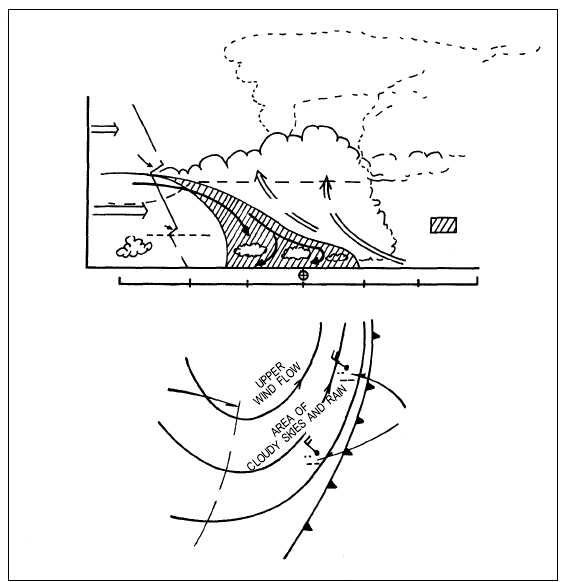approximately 1:100 miles. Near the ground, the slope
is often much steeper because of surface friction.
Figure 4-31 illustrates the typical characteristics in
the vertical structure of a slow-moving cold front. The
lower half shows the typical upper airflow behind the
front, and the upper half shows the accompanying
surface weather. This is only one typical case. Many
variations to this model can and do occur in nature. The
slow-moving cold front is an active front because it has
widespread frontal cloudiness and precipitation at and
behind the front caused by actual frontal lifting.
Surface Characteristics
The pressure tendency associated with this type of
frontal passage is indicated by either an unsteady or
steady fall prior to frontal passage and then weak rises
behind. Temperature and dew point drop sharply with
the passage of a slow-moving cold front. The wind
veers with the cold frontal passage and reaches its
highest speed at the time of frontal passage. Isobars are
usually curved anticyclonically in the cold air. This
type of front usually moves at an average speed
between 10 and 15 knots. Slow-moving cold fronts
move with 100% of the wind component normal to the
front.
Weather
The
type
of
weather
experienced
with
a
slow-moving cold front is dependent upon the stability
of the warm air mass. When the warm air mass is stable,
4-32
200
150
100
50
0
50
100
MILES
PRECIP.
AREA
NIMBOSTRATUS
ALTOCUMULUS
POSSIBLE
CUMULONIMBUS
POINT A
COLD AIR
SUBSIDENCE
INVERSION
FRONTAL
INVERSION
TEMP.CURVE
WIND
ST
ST
AS
15,000
10,000
5,000
ALTITUDE FT
CIRRO-
STRATUS
CIRRUS
UPPER AIR
TROUGH
(SURFACE WIND
FLOW)
POINT A
AG5f0431
0
C
O
0
C
O
WIND
Figure 4-31.—Typical vertical structure of a slow-moving cold front with upper windflow in back of the front.


